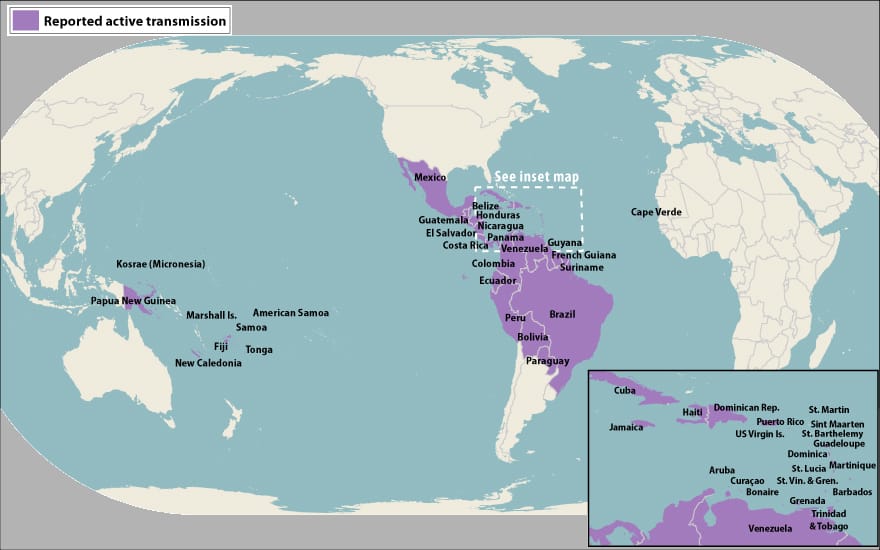Inherently, agricultural and outdoor workers experience a greater risk of mosquito bites that can vector illnesses such as chikungunya, dengue, Japanese encephalitis, West Nile, and Zika virus disease. The CDC and EPA recommend using EPA-registered insect repellents containing DEET, picaridin, IR3535, oil of lemon eucalyptus, or para-menthane-diol to protect workers against these infections. Fact sheets and posters have been released by the Centers for Disease Control & Prevention, Occupational Safety and Health Administration (OSHA) and the National Institute for Occupational Safety and Health (NIOSH) outlining the Zika virus to promote education and communication regarding practices to reduce worker exposure.
The major concern with Zika virus disease is that infection during pregnancy can be transferred from the Mother to her fetus and has been linked to serious birth defects such as microcephaly . The CDC recommends that women who are pregnant follow precautions to prevent the contraction of Zika by avoiding travel to areas with Zika, employing practices to prevent sexual transmission, and by evading mosquito bites. For outdoor workers, protective clothing and personal repellants are the primary means of preventing infection. In addition, outdoor workers whose sexual partners are pregnant or may become pregnant should be aware of the hazards of Zika virus during pregnancy and understand the risk of transmission through bodily fluids and infected blood.
The CDC reports that many people infected with the disease will not show symptoms, while others may experience fever, rash, joint pain, and conjunctivitis (red eyes). The incubation period for the virus is estimated to be up to one week and remains in the blood for about a week. While there is no preventative vaccine, once infected, a person is likely to be protected from future infections. As of mid-May 2016, all Zika cases in the US have been associated with travel to countries and territories with active Zika transmission and have not been locally vectored by mosquitoes. Inform workers who travel to and from countries and territories with active Zika transmission of the risk of infection and the associated health hazards, symptoms, and spread of the disease by travel.
(Image Above: Countries and Territories with active Zika Virus Transmission as of May 12, 2016. Retrieved from: http://www.cdc.gov/zika/geo/active-countries.html)
The Zika virus was first identified in 1947 in a Ugandan forest and outbreaks have since been reported in Africa, the Pacific Islands, and Southeast Asia. In 2015, cases emerged in Brazil, the Caribbean, and the Tropical and Subtropical regions of the Americas. The Zika disease can be spread through sexual contact or vectored by the mosquito species Aedes aegyptyi and Aedes albopictus (Yellow Fever Mosquitoes and Asian Tiger Mosquitoes) which both exist in the southern United States.
Scientists have concluded that a link exists between mothers who are infected with Zika virus during pregnancy and babies with microcephaly. In February 2016, the World Health Organization declared the Zika virus a Public Health Emergency of National Concern. The CDC response includes tracking the spread of the disease, finding and reporting Zika cases, teaching healthcare providers how to identify Zika, finding and testing samples, studying links between Zika and certain birth defects, educating the public about the virus, and advising travelers how to protect themselves in areas with Zika.
Without vaccines or medicines approved by the FDA to prevent or treat Zika at this time, avoiding travel to areas with Zika, educating workers about Zika, and preventing mosquito bites through personal protection practices appear to be the best practices to prevent exposure. Be sure to include insect repellant on your list of PPE (Personal Protective Equipment) and educate workers about Zika virus and other health hazards associated with working outdoors. Review the Zika factsheets released by OSHA & NIOSH and visit the CDC website for more information.
For additional information on preventing mosquito bites and managing mosquito habitats, contact your local UGA Extension Agent.
Fact sheets and training materials for workers and employers:
OSHA/NIOSH Fact Sheet English
OSHA/NIOSH Fact Sheet Spanish
Powerpoint Presentation (English)
Powerpoint Presentation (Spanish)
Information retrieved from the Centers for Disease Control & Prevention at:
http://www.cdc.gov/zika/about/index.html
http://www.cdc.gov/zika/
http://www.cdc.gov/niosh/topics/outdoor/mosquito-borne/zika.html
- Landscape Alerts & Updates | September 2019 - September 20, 2019
- Landscape Alerts & Updates | June 2019 - June 20, 2019
- Landscape Alerts and Updates | April 2019 - April 20, 2019

